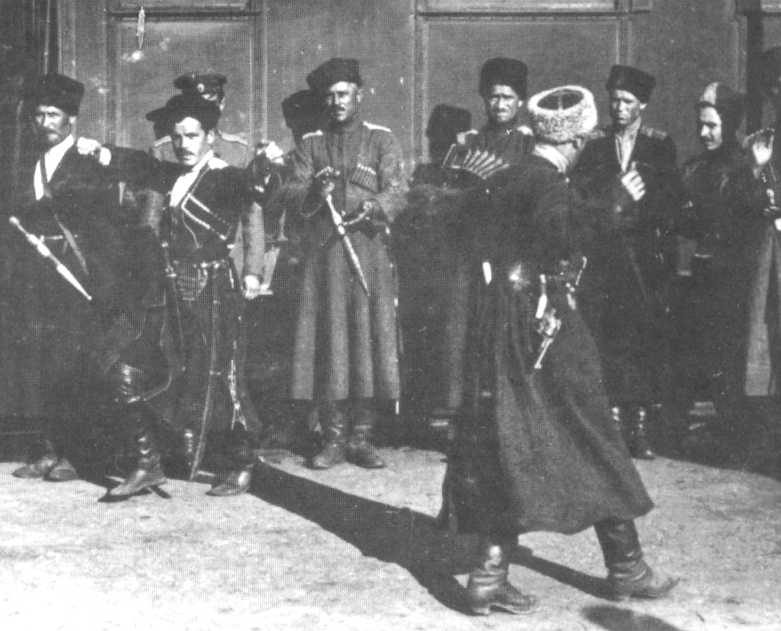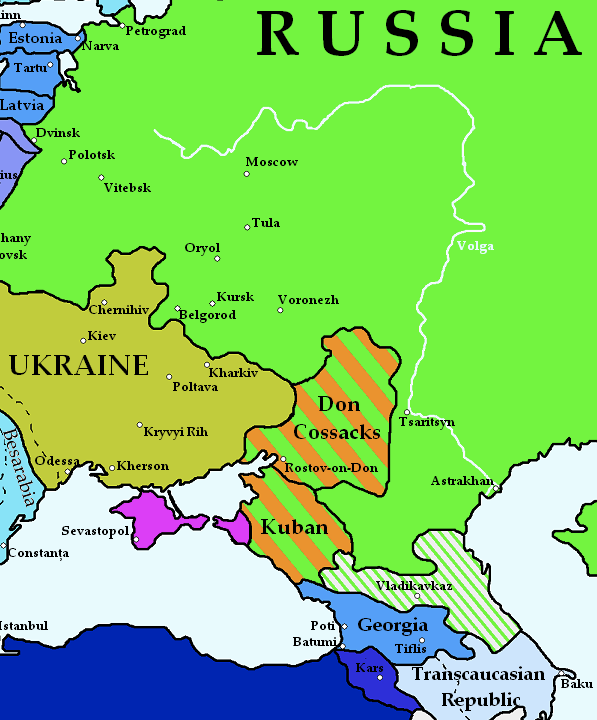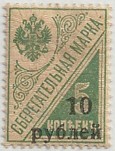ALBUM – view my Kuban Cossack Government
TRANSITION CHART – Ukraine and South Russia
Fast Facts
Region: Russia Area
Group: Ukraine and South Russia
Classification: Revolutionary Government
Prior Regime: Russian Empire
Key Dates:
1917, Sept – Bolshevik Government led by Vladimir Lenin established
1918, Jan 28 – Republic was proclaimed by the Kuban Rada
1918, Feb 16 – Independence declared
1919, Nov – Kuban Cossack Rada captured and disbanded by General Denikin’s White Army
1920, Mar 17 – Kuban Government dissolved
Following Regime: Russian SSR
Scott Catalogue: (South Russia) #20-49
Pick Catalogue: North Caucasus s488=s498E
History

from: pygmy-wars.50megs.com
Finally, in March of 1917, the people, fed up with the massive casualties caused by the war, and chronic food shortages within the nation, revolted and forced Tsar Nicholas to abdicate the throne. A provisional government was formed based on democratic principles, but was overthrown a few months later in Sept of 1917 by the Bolshevik movement (the Red Army), led by Vladimir Lenin. This new, government (which became the Russian Soviet Federative Socialist Republic) began a long and bloody campaign to unite the former Russian Empire under the communist banner. Chaos broke out across the country, and in July 1918 the Bolsheviks had the royal family killed to avoid having them serve as a focal point for the anti-Bolshevik movement (the White Army).
The Cossacks are a groups of military communities who lived in remote frontier areas the Russian Empire. The purpose of the Cossack Hosts were to protect various border areas of the Empire from invaders, as well as secure important trade routes. In return, the Empire allowed them to live with a degree of autonomy and independence. The Cossack Hosts were fierce and proud fighters and were extremely loyal to the Empire.
The Kuban Cossack Host lived in southwest Russia along the Kuban River, bordering the eastern Black Sea and the northern slopes of the Caucasus Mountains. Known for their fierceness and their loyalty, they made up the core of the Tsar’s personal bodyguards. Therefore, with the outbreak of the Russian Civil War, it is not surprised that they initially aligned with the anti-Bolshevik White Army in the south of Russia.
After the fall of the Empire various groups competed for control of the Kuban territory. The three primary factions were the: Kuban Rada (the former ruling parliament of the Kuban Cossacks) which proclaimed the “Kuban People’s Republic”, the Bolsheviks, mostly rural farmers and workers, proclaiming a Kuban Soviet Republic, and the Kuban Military Council, which supported the White army efforts in South Russia under General Denikin. The Rada officially declared independence of the Kuban Cossacks on Feb 16, 1918, which was not supported by the Kuban Military Council nor the White Army of General Denikin. The Rada tried to gain recognition of the Republic including aligning with other fledgling Republics in the region (Ukraine, Azerbaijan and Georgia). These efforts further isolated the Rada from White Army in the south under General Denikin, as well as the Triple Entente (Britain, France and Russia) which supported Denikin. Early in November, 1919, the White Army, with support from the Kuban Military Council captured the members of the Rada and executed them. Most Kubans joined the White Army of the South.
The alliance with short lived, because Denikin’s army was already in retreat from a devastating defeat at the hand of the Red army in Oryol.
By early 1920, the Bolsheviks had overrun most of the Kuban region and the soldiers of the Volunteer Army, along with their families had fled to Crimea. All of the Cossack Hosts across Russia were disbanded in 1920-22 at the end of the Russian Civil War.

Stamps
 ALBUM
ALBUM
In Nov 1918, the Kuban Military Council in Ekaterinodar (today Krasnodar) began surcharging coat of arms stamps of the former Russian Empire with higher values. Initially, four values were issued: “- 25” on 1k”, “- 50” on 2k”, two different styles of “1p” on 3k and “-3- рулeи́” on 4k. Both the perforated and imperforated variety were surcharged except the 3 ruble which was only on the perforated variety.
From Jan – Mar, 1919, two additional values were issued with multiple variations of the base stamp and surcharge variation configuration.
• “-70k” on 1k (perf and imperf)
• “10 рублeи́” on 4k (perf)
• “10 рублeи́” on 15k (perf and imperf)
• “10 рублeи́” on 1k Russian postal savings stamp
• 10 рублeи́” on 5k Russian postal savings stamp
• “10 рублeи́” on 10k Russian postal savings stamp
Finally, in Jan 1920, just prior to the arrival of the Red Army, a 25 ruble. Three surcharges were issued:
• “70 коп” on 5k (perf and imperf)
• “25 рублeи́” on 3k (perf and imperf)
• “25 рублeи́” on 7k (perf)
• “25 рублeи́” on 25k (perf)
Banknotes
Banknotes in the Kuban are somewhat complex: Kuban Army issued notes under the authority of General Denikin in Ekateriodar in 1918 (Pick s491-498E), the Bolsheviks issued bond notes in 1918 (Pick s491-494) and the Rada issued a single 250 ruble note in 1920 (Pick 488), shortly before their dissolution.
Links
Kuban Cossacks from Wikipedia
Kuban Cossack Government from Wikipedia
Kuban Cossacks: Formation history of the Kuban Cossack Host
Uniforms of the Kuban Cossacks
Stamps of the Kuban Territory from Wikipedia Commons
Banknotes of the North Caucasus from AST Notes including Kuban and Ekateriodar, Government Bank Branch




